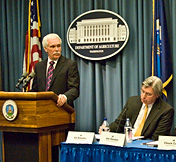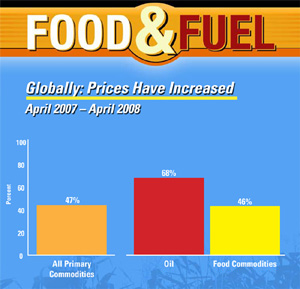 The National Biodiesel Board has recognized a group of U.S. Department of Agriculture researchers for finding new uses for natural glycerine, a by-product of biodiesel production, replacing glycerine made from non-renewable petroleum.
The National Biodiesel Board has recognized a group of U.S. Department of Agriculture researchers for finding new uses for natural glycerine, a by-product of biodiesel production, replacing glycerine made from non-renewable petroleum.
This press release from the NBB has details:
For their research, Drs. Richard Ashby, Daniel Solaiman and Thomas Foglia of the USDA’s Agriculture Research Service Eastern Regional Research Center (EERC) in Wyndmoor, Penn. received the 2008 Glycerine Innovation Award. The award recognizes outstanding achievement for research into new applications for glycerine, with particular emphasis on commercial viability.
The award, sponsored by the National Biodiesel Board and the Soap and Detergent Association, was presented today at the 99th Annual Meeting of the American Oil Chemists’ Society in Seattle, Washington.
“Through the development of new eco-friendly commercial uses for glycerine, the USDA is making an important contribution to our global environmental sustainability,” said Steve Howell, NBB’s Technical Director. “Commercial uses for natural glycerine help improve the overall value of biodiesel production while finding new uses for environmentally friendly, domestically produced products that can replace petroleum-based products.”
The biodiesel glycerine is being used in a wide variety of products from cosmetics to hard plastics.


 During a Monday press conference, Secretary Ed Schafer said he had talked to the people who have “initiated these underground things that have been going on” to influence public opinion about ethanol incentives and found that while they understand that higher energy and transportation costs are the driving factor for increased food prices, they think “it’s easier” to target corn and ethanol.
During a Monday press conference, Secretary Ed Schafer said he had talked to the people who have “initiated these underground things that have been going on” to influence public opinion about ethanol incentives and found that while they understand that higher energy and transportation costs are the driving factor for increased food prices, they think “it’s easier” to target corn and ethanol.  I’m taking off for Indianapolis in about an hour. This year, I’ll be handling the Indy 500 on my own. The race isn’t until Sunday, but the
I’m taking off for Indianapolis in about an hour. This year, I’ll be handling the Indy 500 on my own. The race isn’t until Sunday, but the  On Thursday, EPIC will host the Ethanol Summit and Panel Discussion. Guest speakers include Joie Chitwood of the Indianapolis Motorspeedway, Andy Miller, director the the State Department of Agriculture, Eermson Fittipidi, a two-time Indy 500 winner, Brazilian ethanol producer and driver of this year’s felx-fuel Corvette Z06 pace car, Bill Becker, president and CEO of LifeLine Foods – the provider of the E100 racing fuel for the IndyCar Series – and more.
On Thursday, EPIC will host the Ethanol Summit and Panel Discussion. Guest speakers include Joie Chitwood of the Indianapolis Motorspeedway, Andy Miller, director the the State Department of Agriculture, Eermson Fittipidi, a two-time Indy 500 winner, Brazilian ethanol producer and driver of this year’s felx-fuel Corvette Z06 pace car, Bill Becker, president and CEO of LifeLine Foods – the provider of the E100 racing fuel for the IndyCar Series – and more. “We think the time has come for USDA to join in the public conversation about the relationship between food prices and biofuels,” said Agriculture Secretary Ed Schafer. “We want to offer our perspective and what has happened in the marketplace, to share our data and the analysis of what has happened.”
“We think the time has come for USDA to join in the public conversation about the relationship between food prices and biofuels,” said Agriculture Secretary Ed Schafer. “We want to offer our perspective and what has happened in the marketplace, to share our data and the analysis of what has happened.” The Energy Policy Act of 2005 includes provisions enabling the EPA Administrator to grant a full or partial waiver if implementation of the RFS would severely harm the economy or environment of a state, region, or the entire country, or if EPA determines there is inadequate domestic supply of renewable fuel. In consultation with the Departments of Agriculture and Energy, EPA must decide on a waiver request within 90 days of receiving it.
The Energy Policy Act of 2005 includes provisions enabling the EPA Administrator to grant a full or partial waiver if implementation of the RFS would severely harm the economy or environment of a state, region, or the entire country, or if EPA determines there is inadequate domestic supply of renewable fuel. In consultation with the Departments of Agriculture and Energy, EPA must decide on a waiver request within 90 days of receiving it. 
 The senator made the remarks during his first campaign stop in the state that is becoming a leader in wind energy production in
The senator made the remarks during his first campaign stop in the state that is becoming a leader in wind energy production in  Renewable Energy Group (REG) of Ames now runs animal fats in at least four of its seven biodiesel plants in the state, according to Gary Haer, vice president of sales and marketing.
Renewable Energy Group (REG) of Ames now runs animal fats in at least four of its seven biodiesel plants in the state, according to Gary Haer, vice president of sales and marketing. Carlos Riva, president of cellulosic ethanol firm
Carlos Riva, president of cellulosic ethanol firm  Passage in the committee gained
Passage in the committee gained